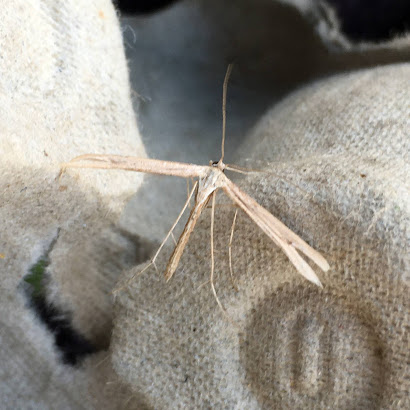Although the moths continue abundant, I thought on first inspection on Friday morning that there was nothing of interest in the trap. Then, while packing back the eggboxes to protect the sleepers from hungry birds, I spotted this little chip; and he or she does have a story to tell.
Meet Blastobasis adustella, a typically sonorous Linnaean name but better, for once, than its English counterparts are Furness Dowd or Dingy Dowd. The latter is taking it a bit far as although the poor thing's colours are indeed dowdy, the chevron mark does give it some distinction.
I couldn't resist Googling 'dowd' by the way and found it to mean 'a person of dull and unfashionable appearance', a seldom-used noun from a commonly-used adjective, even though its first written use was in mediaeval times.
Its interest is as an 'adventitious species' - hence my groanworthy pun in my heading. These are defined as creatures, not necessarily moths or even insects, which take advantage of something outside the natural world to spread their range. In the case of adustella, the something was the horticultural trade. The first arrivals of the moth in the UK almost certainly came, un-noticed, with consignments of plants from overseas for garden centres.
You can be forgiven for not noticing them. They are tiny-weeny, just a few millimetres long though the full wingspan can reach 19mm. They were first recorded in the UK in 1984 and may have come from Madeira which is a stronghold of the Blastobasis family. Adustella has loads of relatives and a really careful moth recorder would attempt to carry out difficult checks in case their find was the very similar B. maroccanella which has also begun to make a home here. I am afraid that does not include me.
More conventional arrivals included the visitors below: a couple of Common Waves with their slightly orangey, delicate bars (Update: Thanks once again to Edward - the first is a Common White Wave, sorry) and a Common Plume with a little gap in its wings which are usually as tightly-furled as an old-fashioned City gent's umbrella.





On the waves the first photograph is a Common White Wave but the second is Common Wave.
ReplyDeleteEdward
Much obliged, Edward - have put that right. Thanks and all vb, M
ReplyDelete